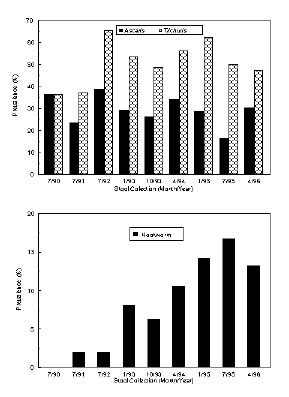Volume 3, Number 3—September 1997
Dispatch
An Increase in Hookworm Infection Temporally Associated With Ecologic Change
Figure

Figure. Upper panel: The prevalence of Ascaris (solid bars) and Trichuris (hatched bars) for each of the indicated stool collection periods. Lower panel: The prevalence of hookworm infection for the same collection periods. A total of 881 stools were examined after Formalin-ethyl acetate concentration (mean 98 per collection period, range 33-174).
Page created: December 21, 2010
Page updated: December 21, 2010
Page reviewed: December 21, 2010
The conclusions, findings, and opinions expressed by authors contributing to this journal do not necessarily reflect the official position of the U.S. Department of Health and Human Services, the Public Health Service, the Centers for Disease Control and Prevention, or the authors' affiliated institutions. Use of trade names is for identification only and does not imply endorsement by any of the groups named above.